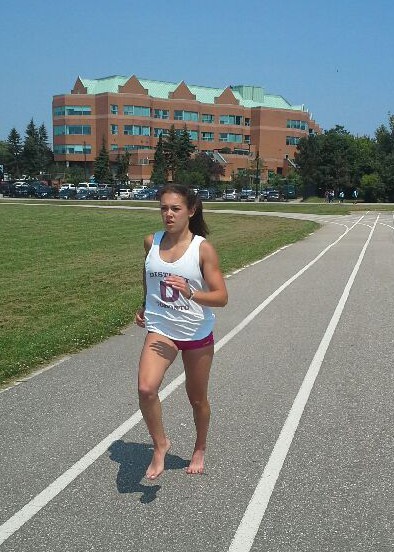In last week’s blog, I introduced you to Mackenzie Lemieux, the Cornell University cross country and track running star from Toronto. This being the 3rd week of me working with her as a client, I wanted to present a series of photos that chronicle Mackenzie’s transition to a safe, efficient and even more powerful runner.
Follow along…
- Picture #1 – the 100 Minor drill (lifting 1 foot up and down for 100 strikes on the same spot). The left hip is dropping. This was corrected by getting Mackenzie to activate her right gluteus minimus and medius.
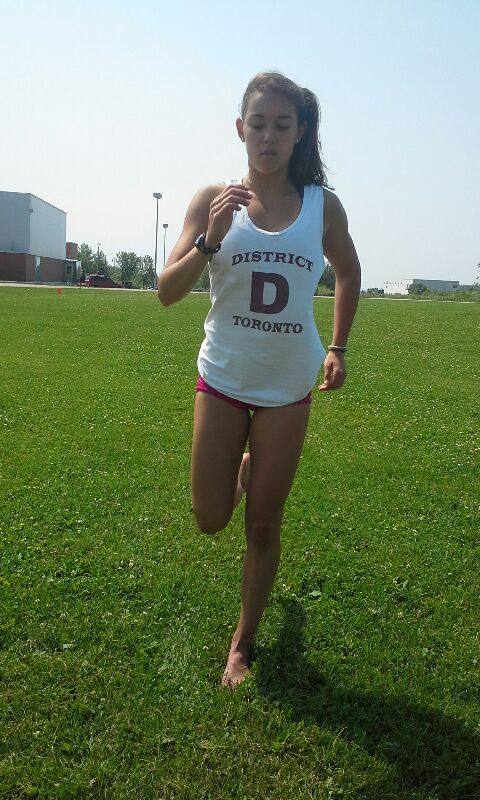
- Picture #2 – the 100 Minor drill corrected.
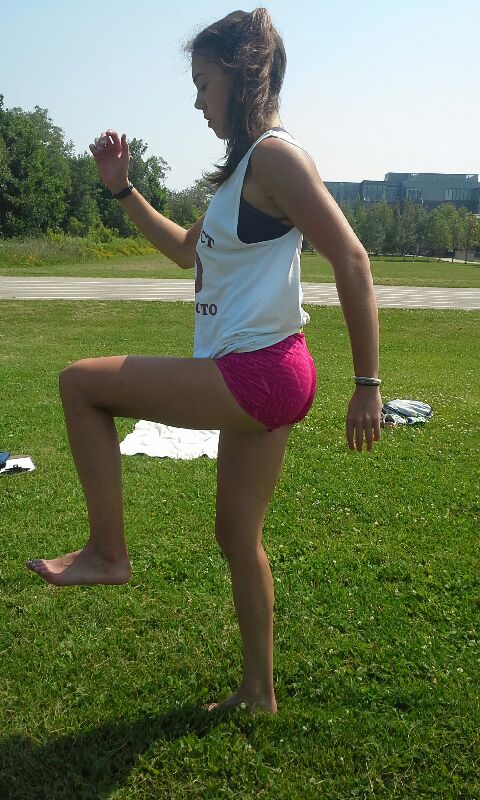
- Picture #3 – the 100 Major drill (as above except done running on the spot. The key again is NOT to travel). Good firing sequence but letting go in upper body – thus, traveling forward (see Picture #4 with feet imprints in grass).
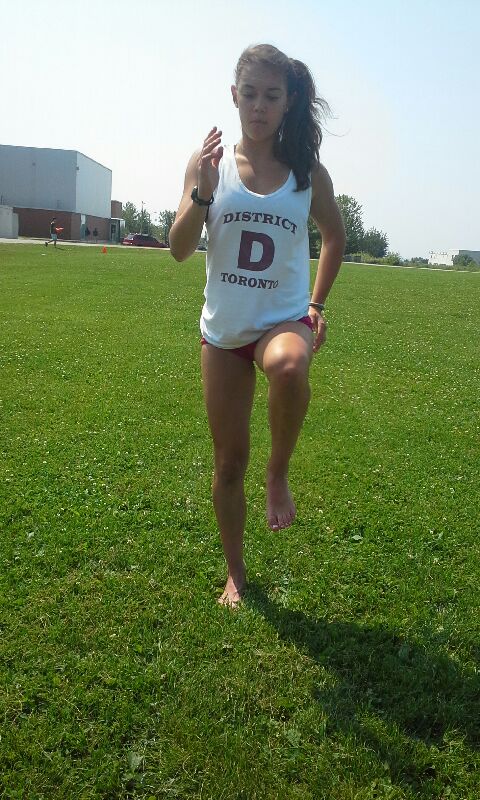
- Picture #4 –
- Picture #5 – barefoot running but shoulders rotating out of control (not bracing through chest and upper back). Right hand clenched thus increasing muscle tension through the upper body and increasing premature fatigue. Right knee locked on landing which, done repeatedly, can lead to shin splints, runner’s knee, femur stress and so on. No forward knee drive.
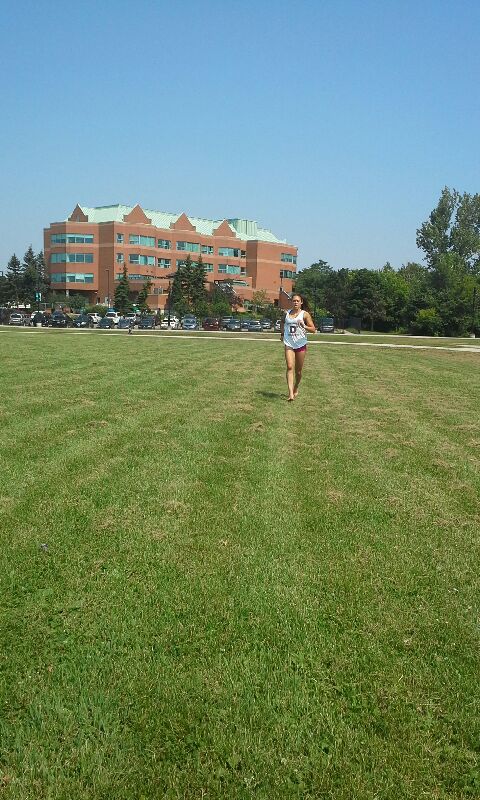
- Picture #6 – corrected most of the above issues by bracing the whole core and squatting lower throughout but still clenching right hand. Letting go on right gluteals during push-off phase.

- Picture #7 – much better technique when barefoot on the track. She is getting direct sensory feedback that translates into more symmetry and better squaring up of the body. Good pawback action with great knee drive forward to enhance landing on the mid foot.

- Picture # 8 – notice when in running shoes (even with the Barefoot-Science inserts in place – albeit, she is only at Level 1 of 7), Mackenzie has lost all direct sensory feedback with the track. Thus, she has let go in the gluteus maximus leading to severe supination and locked knee on landing. This in turn leads directly to her problems with shin splints, femur fractures and lower back strains. Further, she is back to clenching her fist, thus throwing off her balance.

- Picture #9 – note much better technique with corrections made and changes put in place. She still needs work on the pawback action and less forward lean from the hips (activating her low back muscles).
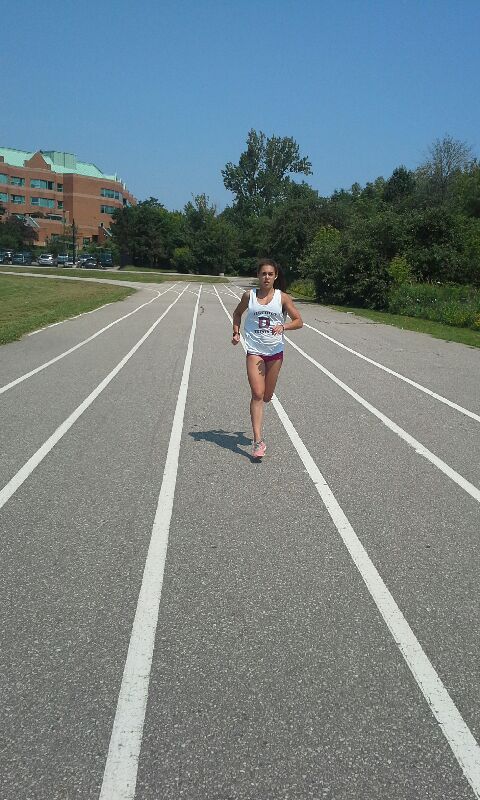
- Picture #10 – this is the Barefoot-Science 3/4 length insert in Mackenzie’s cross country running spikes. She is in the early phases of using them but she already notices NO low back pain post run and workout.

- Picture #11 – Cross Country hill running. On the uphill, Mackenzie’s arm drive is too low. She is not forward leaning from the hips up to match the angle of the hill. Good knee drive, perfect heel position and the landing leg is bent with foot striking behind the mid-line of the body. This propels her up the hill efficiently and powerfully with no injuries.

- Picture #12 – on the uphill. Better drive along the slope of the hill with a lower knee lift and better forward lean. Stronger arm action for better propulsion and less strain on the skeletal system.

- Picture #13 – on the downhill. Landing foot is too far forward, causing the body to brake. This puts too much strain on the skeletal system and often leads to injury. I worked on getting Mackenzie to weave down the steepest segments – this maximizes the effective use of gravity with no strain on the skeletal system.

- Picture #14 – on the downhill. Better foot landing but knee still too locked up. Working on the squat part of bending the knees on impact. Better heel flick to bring knee forward faster and allow gravity to do more of the work. Still needs to lean forward more and trust her body to keep up with the gravitational forces downward.

We are in the early phases of transitioning Mackenzie to an injury-free, efficient and even MORE powerful runner. As you can see and read, great progress has already been made on the track and the trails. I look forward to further progress in the coming weeks.
coach Jeff
